Executive Summary
Consumer purchase decision is influenced by external factors used as stimulus in store design. These factors enhance the consumer capacity to assess the stimulus meaning and initiate a response in them to involve in more purchases. Customer behaviour modification during shopping is based on the perception of customers. Store designing and layout concentrate on consumer psychology that directs their behaviour to do more purchases. Retail marketing strategies identify these factors and each business can customize these factors to influence purchase decision depending on the type of business and its objectives.
Brand equity is built over a period of time depending on the quality of goods and services being offered by the producers. Consumer’s perception about the brand and product offering defines value chain of purchases that will occur in series. All organizations dealing in retail products aimed at increased sales revenue through driving consumers towards the retail outlet. Among the major concerns for organization are the selection of location and the designing of retail outlets that initiate product attraction in consumers and motivates them to involve in its purchase. These factors derive the consumer demand and result in impulse purchase. Store designing and shelf arrangement; involvement of colour and texture pattern facilitate random impulse purchases by consumers and hence they spend more money for immediate need satisfaction.
Psychology of Consumer Purchase Decision
Initially the main motive that derives consumer to make purchases is the satisfaction of their need and their desires. Desires are the main factor that facilitate the motivation level of consumer; eventually makes him capable to search for effective ways for need fulfilment. Consumers are the prime target of any organization as they generate sales by purchasing products produced specifically by the organization; however, organizations segment the consumers on the basis of their characteristics into different segments to design its marketing strategy explicit to each segment. These market segments illustrate diverse distinctiveness but are homogenous internally. Hence, it is easy for marketers to assess the attractiveness of each segment for any particular product or brand and determine the aspects of indulging in buying behaviour.
Analyzing the need fulfilment behaviour and assessment of buying behaviour outlines the main features of each market segment; since each market segment is internally homogenous therefore it is preferable to assume that combination of marketing mix for particular segment will instigate same consumer response about a product purchase (Cox & Brittain, 2000; Evans & Berman, 2007). Consumers consider many factors internal to their state of thinking that acquire perception pattern and semantic formation. This linkage formation about the product and related organization is dependent on various factors, external to the person and hence gives an opportunity to the organization to create a unique position of their product or brand. Consumer may go through a series of product evaluation for his need or want fulfilment or may involve in impulse buying result through an interest formation that require immediate need satisfaction. Such reactive needs arise as a result of stimulus interaction with the consumer that inspire his behaviour formulation and motivates him to involve in product purchase.
Stimulus Impact on Customers Interest
Organizations need to carefully design its brand image in accordance with the product and its offering values. Each brand image conveys an implicit message to the consumer about the product, classifying the brand features and its associated benefits. Consumers interpret messages in accordance to their level of understanding and perception; although new stimulus appear to form a unique perception image but in certain contexts preset behaviour is closely related to the depiction of response based on the correlated stimulus impact such as red colour heart as brand logo will convey an implicit message of product related to internal emotional state of a person. Marketing strategies indeed focus on building an interest for the product followed by purchases by the customers of that particular product (Gilbert, 2006; McGoldrick, 2002). Marketing thus classify the role of its distinct activities undertaken to achieve specific objectives.
Retail Marketing Strategy and In-Store Purchases
Retail marketing concept revolves around consumer and the point of purchase; consider the point of purchase as hybrid stimulus that creates need arousal state and offer solutions to people for the immediate satisfaction of it (Roberts & Berger, 1999). Retail outlets are therefore made in conjunction with the retail marketing objectives; either to build interest in consumer to make perception about the products, and ultimately in other context offer an opportunity to the marketers for devising a plan having partial impact on consumer needs and customers desires directing his behaviour to make random unintentional purchases. Factors hereby affect consumer state of mind are rational to the situation and external in environment, designed specifically to involve customers in making purchases and realize its importance for their need deficiency state. People’s likeness and evaluation affects the stimulus that would be effective to have maximum impact on consumer interest building behaviour (Perner, 2008). Retailers offering a range of products in multiple categories recognize the market consideration for objects used to demonstrate the store offerings; subsequently uses a set of stimulus to derive customers for random purchases in store.
Store Design and Consumer Perception Formation
Customer behaviour pattern analyzers and psychologists place greatest emphasis on perception formation in the mind of consumer reflecting his way of thinking and affecting attribution characteristics that customer associate with the store features and set expectations. Consumer value propositions are therefore require to be formed in accordance with the upbeat and off-putting concern from customer standpoint. Customers purchase behaviour may follow a sequential path of decision making or it may be impulse based on attractive featuring and store environment stimulus impact on customer behaviour (Perner, 2009). Consumer purchase decision is influenced based on the product attributes, location (sales outlet), store design, product benefits and means of communication adopted to convey the attributes. However, retail marketing strategies signifies the extreme importance of store design in order to influence consumer purchase behaviour. Retail marketing mainly characterizes the customer purchase level on strategies used to amuse the behaviour of passers-by that result in impulse purchase; focus on creating an additional want in the customer during purchase state which influence him to make more purchases to achieve the level of needs satisfaction.
In Store Factors to Influence Customers Purchases Level
Retail marketing management main purpose is to provide a unique and attractive purchase environment to the customers which have a significant impact on the sales revenue of a particular sales store. Concentrating on the essential factors involve in deriving customer’s behaviour reveals distinction in its importance and appropriateness to business demand. Store design actually comprises of physical attributes conveying an implied message to the customers affecting his purchase level (Pappas, 1999). These influential stimulus include the spatial differentiation of the store, lightning, atmospherics, colours used, store layout, types of products offering and signage; all combine to have a moderating effect on purchase behaviour of the customer (Levy & Weitz, 2007; Evans & Berman, 2007). Their arrangement may depend on the products being shelved inside the store, purpose of the store to attract a specific market segment of consumer having almost similar needs and wants. Store design is considered to have positive or negative impacts on consumer perception and actual state of action (purchase action).
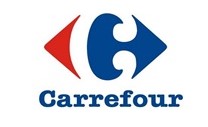
Brand logo and image in actual conveys an interpretive message to the general public. The message strength and intensity will be solely based on the appropriated target market attraction and interpretation by the potential customers. This shows that brand logo is devise for the effective positive perception formation by affecting cognitive latitude of acceptance of consumers that may act as customer or build customers for the company. Colours used in the brand logo are associated with the characteristics of the product and hence consumers set an expectation about the brand and product before indulging in actual purchase. Carrefour logo showing direction arrows at end having red colour on one end and blue on other conveys a message of offering all daily use products for customers in one place. Customers can start their shopping from one site inside store represented as red and they will discover many products as they move.
Spatial differentiation
Spatial differentiation of the store concise on the flexibility and smoothness of the store arrangement that refers to the concern focused on customer visibility to all products being placed in the shelves (Bourlakis et al., 2009). Let’s consider an example of Carrefour, retail operator across the globe in many countries placing its arrangement system in the form of hypermarkets, supermarkets, discount and convenience store. It has segmented the goods according to its categories and has divided the spatial capacity of its respective retail outlet in order to arrange as many products relating to specific category together (Carrefour, 2009).
Customers feel comfortable when searching for a specific brand and get access to other brand to compare it with chosen brand before purchase on the spot; possible only if spatial differentiation and product arrangement are in coordination with the objective of effective space utilization (Zentes et al., 2007). This focuses on more goods placement inside the store so that customers can have one stop solution for their needs. Similarly in relation to its impact on buying behaviour is the understanding of spatial arrangement by the store designer for the effective placement of goods in vision length of customer that gives him access to many products related to his need and personality (other than need but represent social status of customer). Spatial differentiation result in creating space for the customers and placement of the goods in essence of the market need for the respective customers. Proper arrangement of product and allocation of specific limited space for each assigned purpose that creates openness in the environment structure; consumer also feels relaxed inside the environment as more products with proper orientation are in the eye contact of the customer. Product orientation over here refers to the customer’s ability to actively see the brand of the product placed altogether. Such as in Carrefour, a person standing in groceries area can view the other products available in specified location based on the product visibility that include garments or other such as electric appliances, beauty and personal care etc. (Carrefour, 2009). This visibility due to spatial differentiation builds an interest in customer to do more purchases in supermarket or store based on his interest level and financial capability.
Lightning
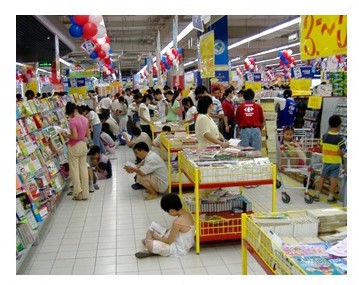
Another factor that most importantly valuable in store design arrangement is the lightning affect produced to create luminosity. Lightning increases the visible power of customer to see goods properly and attractive lightning effect also encourages customer to take a closer look at all sections of the store (Zentes et al., 2007). Such as in disco and night clubs, light is kept dark whereas lighting effect of multiple colours such as red, blue, green and pink is produced to add on magnitude in the environment. This lightning arrangement is totally based on the requirement and is effective to the extent of deriving customer through subliminal responses generation. Customer ultimately attract towards the bright lights as in case of Carrefour where bright yellow and white luminous light affect creates an attractive environment inside the Carrefour market stores and outlets (supermarkets & hypermarkets) as shown in figure. This focus on attraction and interest part of retail marketing AIDA plan; draw customer’s attention towards itself and unintentionally customers like to spend more time inside the store due to energetic atmosphere. This signifies the role of lightning as driver towards the store which ultimately in relation to other factors motivates consumer to make more purchases.
Atmospherics
Atmospherics and colours use inside the store convey a subliminal message to the consumers affecting the customer intention level; schematic network linkages hence add a specific response to the stimulus specified above and customer response becomes more generic apart from external stimulus impact. Vivid and strong colours are more appropriate to use in stores dealing in fashion products, whereas metal colours suits the need of automobile parts store. Departmental stores also play theme music either to increase the customer time spent inside store or to decrease time in case of queue management (Bruce, Moore & Birtwistle, 2004). Such atmospherics are actually driven forces that affect customer cognitive pattern or schematic networks; subliminally influencing customer to involve with the purchase. People’s likeness about a product increases when it is visually congruent with subliminal responses, and thus customer make impulse purchases just to satisfy his initiated need of excitement conveying an emotion or feeling. Colours used inside the store affects the customer likeness and hence increase his visual capacity to direct buying behaviour due to attention directed towards product as reason for response towards colour stimulus as in case of Carrefour which has place emphasis on white and off-white interior store outlook.
Store Exterior Design
Store exterior designing and layout gains considerable importance in attracting customers’ market share in competitive environment. Organizations focus on suitable retail outlet to the market need driven factors. Classifying the designing and layout of store distinct in many parts that include entrance setting, floor ceiling, type and quantity of glass used at the front, and wall-paint textures. These things combine to form an impression about the standard of the store/retail outlet; consumer interpretation about the evaluation of the product is also dependant on above specified features to influence buying behaviour. For example Carrefour has used tiled floors at many retail outlets locations; presenting it as a hygienic and clean environment store, and therefore customers also interpret the things present inside the stores as valuable and hygienic for them. Big entrance gate to manage customer flow from psychological perspective widens the perception of customer about the store and hence overall expectation is also set positively.
Wall paint colour and texture formation delights the consumer attitude involved in shopping inside the store; subsequently this attraction and delightedness propels customer to spend more time inside the store and make more purchases. Many stores have full glass ceiling at the entrance that shows the opaque nature of store presenting the view of store to people who feel complex to visit new store by considering cost alternative. Such presentation clears the perception of customers about the retail outlet as they may feel it to be more oriented towards product offering and defining the appropriated target market.
Shelves Arrangement
In many stores, shelves arrangement also influences the consumer buying behaviour (if no other price constraint factor is involved) to the extent they feel it more enriched with providing access to goods (Matthew et al., 2009). Consumers like to purchase valuable goods when arranged in ‘free form’ store layout; such as in Carrefour separate shelves for office products, baby care products, fresh food and electronic gadgets and equipments. This form of arrangement builds-in customer propensity to explore the store along with making more purchases. Products visibility increase in free form store layout as shelving arrangement with proper lightning gives better access to view things and hence consumer can get attracted towards it.
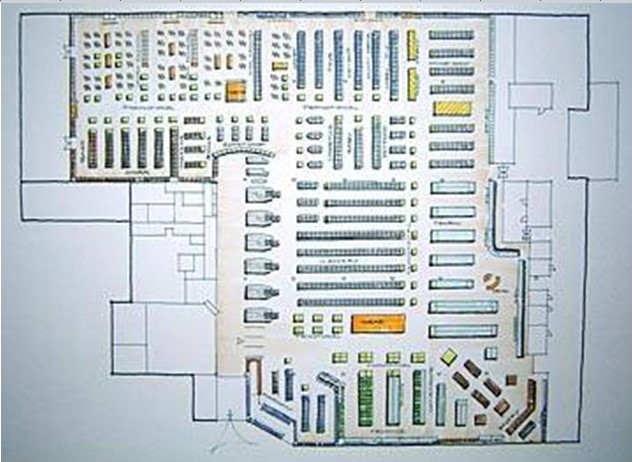
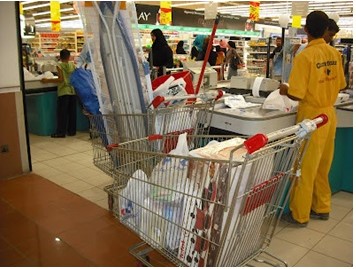
Some retail outlets follow the grid layout structure in order to effectively manage the limited space. Product placing is related to category in each gondola and shelf in order to make it easy for customer to find goods. Such arrangement gives customer ready to buy approach when customer passes by aisles; used extensively by stores focus on providing relatively cheaper and valuable goods at low price where arrangement in shelves is to offer selection benefit to customers in less time (Bruce, Moore & Birtwistle, 2004). The given figure shows the store layout with having different arrangement of shelves and gondolas. Arrangement of shelves is in free form at the upper right corner whereas grid layout structure has been given more importance. In Carrefour food and groceries section shows the grid layout structure and other sections such as healthcare and bio, beauty and personal care shows free form arrangement. Customers main emphasis is to involve in purchase to the extent things are required. Therefore other features involve in store design originate customer responses for more purchases made in the store.
Promotion Activities Impact on Purchase
The major factors in influencing customer to make purchases from a particular store is based on the promotion offers and marketing activities of the organization for any particular product placed in store (Hoekstra et al., 1999). However, retailing mix marketing approach comprises of discount available for specific quantity purchase, location of the outlet, relation with the retailers, profit margin given to retailer to decide products place in shelves, and specific services provided by manufacturer to the retailers in order to influence their behaviour for brand recommendation to customers (Bruce, Moore & Birtwistle, 2004; Varley, 2006). Such as Carrefour UAE has been offering customer Eco Shopping Bags which they can replace free of charger for life (Carrefour UAE, 2009). These retailing mix models also have an effect on the customer purchase in store (more than needed). Subsequently, concerning retailing marketing strategies impact on the customer spending pattern in the store and perception formation in association with psychological influence on customer need makes them to indulge in impulse buying.
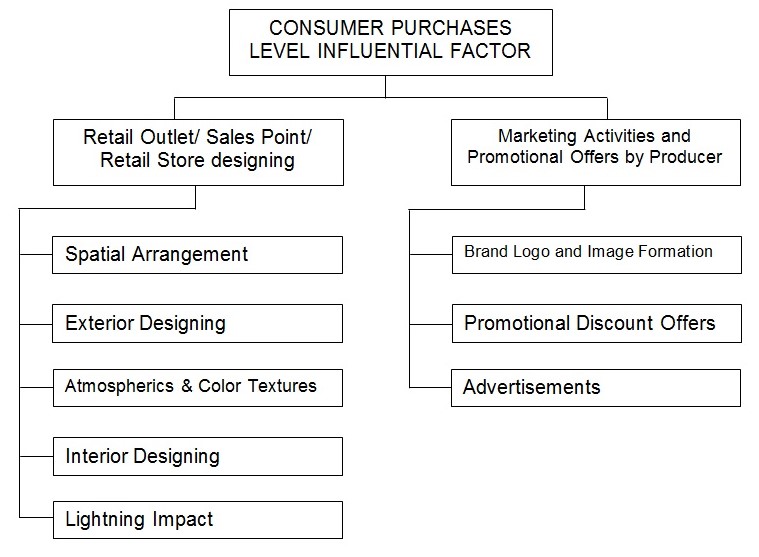
Store Design Relation With Purchases Level
In considering the cumulative effect of above specified factors on the customers for increased purchase level signifies that store design convince and derive consumer demand for more purchase for the satisfaction of basic needs or wants such as fun, excitement, social status representation; depending on the type of product and its value perception according to the perspective of customers. The things that have been identified from the above context revolve around the store image and strategies undertaken to influence consumer perception with respect to proposition offering in competitive environment. Consumers make first purchase only on the basis of customer setting about the store (Perner, 2008). This perception formation is concrete to the retail marketing management strategies to influence the consumer decision making process about to make purchase from a particular store or not relating to building brand equity. In contrast to it, store design conveys a very particular subliminal message to the customer that influence their random or impulse buying behaviour through directing behaviour on product likeness and interest followed to an action of making purchases. Hence, store designing focus on psychological process to persuade more spending by people.
The stimuli specified in above context designed for in-store customer impact rationalize consumer behaviour to make purchases on the basis of their evaluation and interpretation of such factors. As each customer has a relative different personality trait that shapes his behaviour, therefore each stimulus presented in store design will influence customers differently. Although the main objective of retail marketing is to derive need of all customers in same manner whereas store designing and arrangement increases the cost of store operations and therefore force retailer to increase price to some extent or else in other case has to adjust from his profit margin; this condition according to economic perspective may affect the product demand in severe cases.
Conclusion
Store design focus on psychological processes of customer to influence their behaviour pattern about purchasing and deriving their demand to spend more money while shopping due to impulse buying behaviour. Factors such as store layout, spatial arrangement, lightning, colours used, and paint texture encourages customer to spend more time in store while shopping and therefore they spend more money while exploring the place and products. However, in considering the retail marketing strategies, influential consensus is to be shown by the manufacturer of goods to support retail operations of marketing which derives customer to the store by promotional campaigns directed towards building interest in customer to be involved in purchase.
References
Bourlakis, Michael. Papagiannidis, Savvas. Li, Feng. (2009). Retail spatial evolution: paving the way from traditional to metaverse retailing. Journal of Electronic Commerce Research, Volume 9, pp. 135-148.
Bruce, Margaret. Moore, Christopher. Birtwistle, Grete. (2004). International retail marketing: a case study approach. Edition: 1. Butterworth-Heinemann.
Carrefour UAE. (2009). Web.
Carrefour. (2009). Carrefour Home. Web.
Cox, R. and Brittain, P. (2000). Retail Management. Edition: 4. Prentice-Hall.
Cronin, J. Joseph. (1985). Determinants of retail profit performance: A consideration of retail marketing strategies. Journal of the Academy of Marketing Science, Volume 13, pp. 40-53. Web.
Evans, J. and Berman, B. (2007). Retail Management: A Strategic Approach. Prentice Hall.
GBI. (2005). Private Label Strategy in Carrefour. Web.
Gilbert, D. (2006). Retail Marketing Management. Edition: 3. Pearson Education India
Hoekstra, Janny. C. Leeflang, Peter. S. H. Wittink, Dick. R. (1999). The Customer Concept: The Basis for a New Marketing Paradigm. Journal of Market-Focused Management. Volume 4, pp. 43-76. Web.
Interbrand. (2009). Carrefour Store Design. Web.
Levy, M. and Weitz, B. (2007). Retailing Management. Edition: 6. McGraw-Hill Irwin.
Matthew A. Waller, Brent D. Williams, Andrea Heintz Tangari and Scot Burton. (2009). Marketing at the retail shelf: an examination of moderating effects of logistics on SKU market share. Journal of the Academy of Marketing Science.
McGoldrick, P. J. (2002). Retail Marketing. Edition: 1. McGraw-Hill.
Pappas, Lorna. (1999). Store Design. Web.
Perner, Lars. (2008). Consumer Behavior: The Psychology of Marketing. Web.
Roberts, Mary. Lou. Berger, Paul. D. (1999). Direct marketing management. Edition: 2. Prentice Hall.
Varley, R. (2006). Retail product management: buying and merchandising. Edition: 1. Published by Routledge.
Zentes, Joachim. Morschett, Dirk and Schramm, Hanna. (2007). Strategic Retail Management. Edition: 1. Published by Gabler.
Google Images. (2009). Carrefour Store Arrangement. Web.